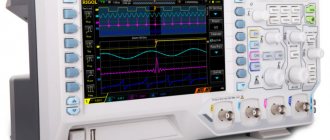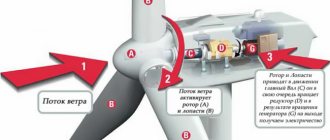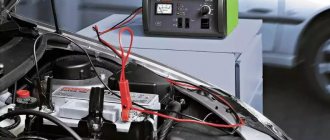An uninterruptible power supply with a built-in battery allows you to filter interference and for some time ensures stable operation of the equipment in the event of an unexpected power outage. The function of storing and providing energy to devices in the event of a power failure in an uninterruptible power supply is performed by a rechargeable battery. The duration of autonomous power supply and the power of the UPS depend on it. For uninterrupted operation, the correct choice of battery is important. Let's look at what types of UPS batteries there are, their pros and cons.
Principle of operation
Rechargeable batteries (AB) are used in UPSs to accumulate and use electrical energy to maintain the operation of equipment in the event of a power supply failure from the main power source. Batteries under the Parus Electro brand are maintenance-free lead-acid sealed with valve regulation and mainly use AGM technology (electrolyte bound in a fiberglass mat with additional separators) to ensure safe battery operation under vibration, shock loads and in any position except upside down.
The operating principle of lead-acid batteries is based on the electrochemical reaction between the plates of lead (Pb) and its dioxide (PbO2) through glass fabric impregnated with a solution of sulfuric acid (H2SO4).
Rice. 1 – diagram of charge (a) and discharge (b) of an AGM battery, where:
- fiberglass material with absorbed electrolyte
- lead anode plate
- lead cathode plate
- direction of current flow
- positive and negative output
During charging of the battery (Fig. 1a) on the lead plate, under the influence of a large number of reactions, lead sulfate (PbSO4) decomposes and distilled water (H2O) is converted into electrolyte (H2SO4), due to this, free electrons accumulate inside the electrolyte absorbed in the fiberglass material.
When the battery is discharged (Fig. 1b), free electrons are concentrated on the cathode plates of the battery when lead dioxide (PbO2) is converted into lead sulfate (PbSO4), and the electrolyte into water. Free electrons are directed through the external electrical connection to the anode, resulting in an electric current.
The period of charging and discharging a battery is called a cycle. With each cycle, the batteries wear out. The durability of a battery is assessed by the number of cycles and depends on the resource built into its electrochemical system and design, as well as installation and operating conditions.
When producing batteries using AGM technology, a separator consisting of glass fibers of various thicknesses from 0.25 microns to 3 microns is tightly placed between the plates to ensure contact of the plates with the electrolyte. A system of pores with a diameter of 1 µm to 10 µm is formed between the fibers, in which the liquid electrolyte is held by capillary force like a sponge.
In gel batteries, the electrolyte is in a bound state due to the use of a substance containing a dispersion of silicic acid particles with a large surface area (200 m2/g). After filling the battery, it thickens to a jelly-like state with the formation of a system of pores with a diameter of 0.1 microns to 1 microns, in which, just like in AGM batteries, the electrolyte is retained and conditions are created for the recombination of gases formed during electrolysis.
By using an absorbed and gelled electrolyte, it is possible to obtain a sealed battery that can operate in any position except upside down.
Reliable battery for backup power supply
Practice has shown that a 12V UPS battery with a capacity of 100 A/h can be considered the best option for use in household emergency power supplies. The battery from the 12-100 battery has established itself as a reliable power source that works perfectly in combination with inverter converters. Such UPSs are often used for heating systems. The “Energy” battery AKB 12-100, when the network is turned off, ensures the operation of a heating boiler with a power of 150 W for 8 hours.
The battery is made using AGM technology, is capable of providing high inrush current for a short time, and is designed for a service life of 12 years. The battery charge current is 30 A, and self-discharge does not exceed 3% per month.
Having compared the types and technical characteristics of modern batteries, we can conclude that a battery made using AGM technology and having a capacity of at least 100 ampere/hour is best suited for use in a household UPS. Such batteries have an optimal price/capacity ratio, are absolutely safe and affordable.
With this they read:
Industrial voltage stabilizer: what criteria should you use to choose?
Voltage stabilizers for the home: reviews, which one is better and what criteria to use to make a choice
Thyristor and triac voltage stabilizers: what is the difference?
Uninterruptible power supply for a gas boiler: types, features and selection criteria
Did you like the article? Share with friends on social networks!
Operating restrictions
Subject to operating conditions, lead sulfate, which forms on the plates as a result of the battery discharge process, disintegrates without problems during charging. However, if a discharged battery is left for a long time, lead sulfate forms an insoluble crystalline form with increased electrical resistance (a process called sulfation or sulfation). Thus, the interaction area (of the fiberglass material impregnated with electrolyte with the plates) is reduced and the battery becomes unusable. For this reason, batteries must always be kept charged. Maintaining a charge in a battery can be problematic due to the so-called self-discharge effect. With this effect, the battery is discharged without the influence of an external load. Storage temperature has a direct impact on this process (Fig. 2). The following table shows the dependence of the time interval between the full charge of the battery and the storage temperature to maintain the required minimum charge level:
| Storage temperature | Recommended battery recharge period |
| 20℃ or below | 9 months |
| 20~30℃ | 6 months |
| 30~40℃ | 3 months |
2 – graph of the dependence of losses in the capacity of an AGM battery on storage time and temperature. The nominal capacity of a battery is the capacity guaranteed by the manufacturer under specified discharge conditions. Charging capacity is the amount of electricity supplied to the battery when charging. The charging capacity is approximately 10-12% greater than the discharge capacity due to the irreversible processes that occur during charging and discharging. After long-term battery storage has ended, their capacity may drop below the nominal value. Full capacity can be restored through several charge-discharge cycles.
Temperature also affects the operation of lead-acid batteries (Fig. 3). Room temperature 20-23°C is optimal for their operation. A higher temperature increases the intensity of corrosion of the plates, which reduces the battery life (every 10 degrees reduces the service life by 2 times, but at the same time increases the capacity). At low temperatures, the electrolyte in the battery cools, which leads to a decrease in the speed of electrochemical processes and, accordingly, a decrease in the battery capacity (approximately 1% of the capacity when the temperature decreases by 1°C from normal).
Rice. 3 – graph of the dependence of the AGM battery capacity on the operating temperature, where CA is the nominal capacity from which the charging current xCA is calculated (x is the coefficient)
When a lead-acid battery is overcharged with an increased current, after the lead sulfate decomposition process has completed, electrolysis of water begins to occur. In this case, hydrogen and oxygen acquire a gaseous state and the so-called “boiling” process occurs. During this process, water is converted into steam and the density of the electrolyte increases, which can lead to deformation of the battery case and its failure. The voltage level of 2.4V per cell at which the water electrolysis process begins is called the “gassing voltage.” In order to prevent such destructive processes, AGM batteries use:
- chargers with automatic voltage regulation, which provide a decrease in charging current as the battery approaches full charge
- Limiting the maximum charge voltage to 2.35 V per cell
- thickened electrolyte enclosed between plates in fiberglass material, which has a significantly lower rate of gas formation during boiling
- sealed plastic housing with an adjustable valve that retains the resulting gas and guarantees its recombination (in the event of excessive hydrogen pressure, an automatic valve releases excess gas)
Due to the properties described above, the consumption of water from the electrolyte is very limited, therefore, during the normal life of the battery, measuring the viscosity of the electrolyte and adding water are not required. This ensures ease of operation, as well as the ability to install a UPS with such batteries in a room where people work or live. It is the safety of use that makes batteries built using AGM or gel technology an excellent choice for use at home and in the office.
Nickel-cadmium batteries for UPS
Ni-Cd batteries for computer uninterruptible power supplies have become increasingly popular in recent years due to their small size and weight, which is why they are increasingly used in portable electronics. They are also used as batteries for uninterruptible power supplies.
Advantages: resistance to temperature changes, ease of operation, high reliability, low cost, low percentage of self-discharge, can withstand up to 1500 recharge cycles, high energy density.
Disadvantages: high cost of disposal and recycling, made from a highly toxic substance, loss of capacity, “memory effect”.
Life time
Battery life is one of the main indicators and is characterized by the number of charge-discharge cycles. The number of cycles during operation primarily depends on how deep the battery is discharged, on the operating temperature, and on the voltage and charging current.
The permissible battery charge voltage is characterized by the following value: “maximum charge voltage” is the number of volts per cell that can safely charge the battery to maximize its service life. High current charging and short discharge duration require a lower charge limit voltage, while low current charging and long discharge operation require a higher charge limit voltage.
You must ensure that the correct voltage is set in accordance with the battery manufacturer's recommendations. Excessive voltage increases corrosion of the positive plates and shortens battery life. Too low a voltage leads to sulfation of the plates, which in turn causes a decrease in capacity and ultimately shortens the life of the battery.
As stated earlier, under normal operating conditions, namely, at 20℃~30℃, voltage compensation for operating temperatures is not required. However, to ensure maximum battery life, temperature compensation should be taken into account for operating temperatures outside this range.
Temperature compensation of battery charging voltage:
- When working in buffer mode: Vt = V-0.003(t-25)
- When operating in the “charge-discharge” mode: Vt = V-0.005(t-25) (V is the voltage used for charging at 25 ℃, t is the temperature, Vt is the charging voltage at t ℃)
The service life of a battery used in the charge-discharge mode (characterized by the charger turning off after the end of the charge) largely depends on the depth of discharge to which it is subjected during each cycle. The relationship of different numbers of cycles to the depth of discharge is shown in Fig. 4.
Rice. 4 – the ratio of the number of cycles and capacity depending on the depth of discharge.
The period of operation in buffer charging mode (when the charging process does not stop, constantly maintaining the battery charge level close to full) largely depends on the temperature at which it is carried out. The period of operation in buffer mode will be very long at low charging temperatures (10~20 ℃), but at high temperatures the battery life will be shortened.
Rice. 5 – Ratio of operating period to temperature
The classification of the EUROBAT association, which unites leading battery manufacturers, implies the following categories according to the estimated service life:
- service life 3-5 years - Standard Commercial (standard commercial)
- service life 6-9 years - General Purpose (general purpose)
- service life 10-12 years - High Performance (high performance)
- service life 12 years and above - Long Life (long service life)
General purpose UPS uses standard commercial batteries. At the same time, the UPS design often provides for the user to replace them independently, taking precautions when working with batteries.
To avoid performance degradation, replacement batteries must be the same type and capacity. Since the technical characteristics of batteries, in particular internal resistance, change significantly during operation, it is not allowed to use old batteries with new ones in the same group. It is not recommended to connect more than 4 groups of batteries in parallel, since due to the variation in characteristics, the charging currents vary significantly, which leads to a reduction in battery life.
Li-ion battery for UPS
Lithium-ion batteries have a high specific capacity, which allows them to be used to power powerful consumers. At the same time, Li-Ion batteries are compact in size and light in weight.
Advantages of lithium-ion batteries: low maintenance cost, no loss of capacity, low self-discharge rate, high energy density, high operational reliability.
Disadvantages: special chargers are required, have an aging effect, storage is allowed only in a charged form, small range of operating temperatures, high cost.
Calculation of battery life
The most important characteristic of UPS batteries is the battery life that they can provide as part of an uninterruptible power supply. To perform such a calculation, it is necessary to accurately understand the operating conditions of the UPS.
Battery life depends on many factors, but the main ones are:
- C is the total capacity of the battery, which is expressed in [A*hour] and is a time-current characteristic (depends on the number of batteries in the discharge current circuit, temperature during discharge, maximum charge voltage, operating and storage conditions)
- V – voltage of the connected battery in volts
- η – inverter efficiency, coefficient depending on the conversion efficiency for the technology used in the UPS
- P – average power of equipment connected to the UPS in watts
- T – operating time in hours, characterizes the period of time supporting the UPS power supply using the battery until it is completely discharged
To simplify the calculation of battery life, use the following formula:
T [hour] = C [A*hour] * V [V] * η / P [W],
Let's look at the calculation method in more detail:
Average power calculation
First, the average active power of the equipment connected to the UPS (P) is determined in watts (indicated by W - watt, not VA - volt-ampere). We need to find out exactly the average (during battery life) consumption. It may differ significantly from the maximum or rated power stated in the equipment descriptions.
Let's look at an example: the rated power of a computer power supply is 500 W - this is the maximum possible power that it can produce. Actual consumption will depend on the installed hardware and may be around 150W.
Another example: an electric heater connected to a UPS operates on an element with an electrical power of 350 W, however, this heater is turned on once every 30 minutes, and its operation lasts 5 minutes. In this case, the average consumption will be equal to:
350 W * 5 minutes / 30 minutes = 58.3 W
Calculation of the total capacity of the battery (rechargeable battery) of the UPS
Typically, a monoblock UPS battery consists of several identical sealed sections. As a rule, batteries with a nominal voltage of 12 volts are used, internally consisting of 6 sections of 2 volts each. A UPS can use from one to forty such batteries as part of one group (a chain of batteries connected in series). Groups can be connected in parallel to increase the total capacity.
It is necessary to find the total capacity of the battery. For this purpose, we multiply the total number of battery groups by the capacity of one group (batteries of only one capacity should be used).
Let's look at an example: the UPS has a built-in battery group consisting of 3 sealed lead acid batteries connected in series with a capacity of 9 Ah (with a 10-hour discharge) and a voltage of 12 volts. In addition, one external battery pack (BB) with six of the same batteries is connected to the UPS. Then the total voltage on the batteries is 3*12=36 V, and the total capacity of the batteries will be equal to:
C10 = 9 A*hour * 3 parallel groups = 27 A*hour
Calculation of operating time from battery
Now we are ready to calculate the operating time of the UPS from batteries:
T [hour] = C [A*hour] * V [V] * η / P [W],
where: C is the total capacity of the batteries, which we calculated earlier in ampere-hours; V is the battery voltage in volts; η is the efficiency of the UPS inverter (if unknown, it is recommended to use the average value of 0.85 for a low-power UPS); P is the average active power consumed by the equipment connected to the UPS, which we calculated earlier in watts.
Continuing the previously discussed examples (a computer consuming 150 W of power is powered by a UPS with three built-in 12-volt batteries with a capacity of 9 A*hour and a connected external battery pack of six 9 A*hour batteries in two groups) we have:
T = 27 A*hour * 36 V * 0.85 / 150 W = 5.51 hours = 5 hours 30 minutes
As can be seen from the formula, the operating time of a UPS from a battery does not directly depend on the power of the UPS. Thus, to increase the operating time of a UPS from a battery, it is necessary, instead of choosing a UPS of higher power, to choose a UPS that has a larger total battery capacity. Or increase the total capacity by connecting external battery packs.
Discharge characteristic
The above formula is quite accurate for long-term operation of the UPS from the battery (more than 8-10 hours). At short discharge times (high discharge currents), the battery is capable of delivering only part of its capacity. This value is precisely reflected in the technical characteristics of the battery, and is approximately shown on the graph (Fig. 6).
Rice. 6 – Battery capacity versus discharge time.
Thus, a more accurate calculation of the operating time from the battery can be carried out using the efficiency value of the UPS inverter at a given power and discharge curves for a specific type of battery.
UPS battery compatibility. How to determine the required capacity of a new battery?
If you cannot purchase original batteries, then buy models from other manufacturers, but be sure to match the basic parameters of the original battery. When choosing, compare the capacity, voltage, sensitivity to overcharging, the ability to operate under deep discharge, and the dimensions if it is intended to be installed in a UPS case.
Be sure to pay attention to the polarity and type of terminals, which must match the UPS design. In most cases, the connection is made using a T1/T2 blade connector or a T5–T10 screw connector, which are used in powerful models.
The required capacity is determined based on the required battery life and the power of the equipment being serviced. The calculation formula is simple:
T=E x U/P,
E—capacity;
U is voltage;
T - time;
P - power.
To obtain a more accurate result, the obtained value is further adjusted using coefficients that take into account the efficiency of the source, the degree of discharge and the available battery capacity.
conclusions
We can briefly summarize the basic information about UPS batteries:
- Batteries should always be stored charged at room temperature with periodic additional recharging.
- Battery capacity depends on temperature: the higher the temperature, the higher, but when exceeding 20°C, battery life begins to decrease
- AGM and gel batteries do not require additional maintenance, and due to gas recombination in a sealed housing, they are safe for use in places where people work and live, subject to operating rules
- Battery life depends on:
- battery discharge depth (the higher the percentage of remaining charge, the better)
- operating temperatures (every 10°C above 20°C reduces the service life by 2 times)
- voltage and charge current (too high increases corrosion, too low leads to sulfation)
- When calculating the operating time of a UPS from a battery, it is necessary to take into account the discharge curves (the dependence of the supplied power on the discharge time).
Nickel Metal Hydride Battery for UPS
Ni-MH batteries are not widely used due to operational difficulties.
Advantages of Ni-MH batteries: no decrease in capacity level, high energy density, stable operation, high specific capacity.
Disadvantages: high level of operating costs, complex charging process, high level of self-discharge, deep discharges have a detrimental effect on the battery, low load capacity, small range of operating temperatures, high cost, small number of discharge-charge cycles.
Which company should you choose?
There are many competitors in the global equipment market, so we note the most common and proven brands in the 2021-2022 battery market: Ippon, Schneider Electric, CSB, Delta . These are Asian manufacturers.
Their factories are located in Japan, China and Taiwan.
They also produce OEM batteries for well-known UPS manufacturers: FSP, Powerman, Sven, etc. More common brands are ROBITON, CSB, Delta, which have proven their quality over time.
Choices
Let us pay attention to the performance characteristics of the main types of batteries used in uninterruptible power supplies.
Lead-acid
This choice differs in the following indicators:
- Devices with liquid electrolyte are reliable, but do not withstand deep discharge well. Must be installed in well-ventilated areas.
- AGM - withstands 300–400 cycles, delivers current well, is unstable to deep discharge.
- GEL - low self-discharge, increased number of cycles, no consequences even with regular serious discharges.
Preference is given to type 2 or 3, despite the fact that the cost of such batteries is higher.
Nickel-cadmium
These batteries have minimal self-discharge, can withstand more than 1500 cycles, and are characterized by minimal dimensions and weight. Good but expensive choice.
Nickel metal hydride
This option is characterized by high specific energy intensity and an average service life, which is still 2-3 times higher compared to acid-lead ones. Among the relative disadvantages, we note poor resistance to overcharging.
Lithium-ion
Promising but expensive batteries. The service life before loss of capacity is increased by 1.5–2 times; they can be operated at temperatures up to + 50 degrees. Modern modifications are characterized by increased safety; cases of spontaneous combustion due to overcharging, as was the case with the first models, are now not observed.
Review of popular models
Yuasa NP7-12
The Yuasa NP7-12 model has an above-average price tag (2.2─2.5 thousand rubles), but according to reviews from its owners, it lasts for at least four years. In some cases even more. The battery operates in a UPS both alone and when combined into batteries of two or more pieces (for example, in rack-mounted server models). There are no serious problems during operation.
By the way, this model with a voltage of 12 V and a capacity of 7 Ah is in demand not only among owners of computers with a UPS. Often these batteries are installed on children's toys with an electric motor. For example, children's cars or small electric scooters. There the battery is operated in a more severe mode, since it is constantly being heavily discharged and charged. But even in this case, it can withstand 2-3 years of moderate use.
Delta DTM 1207
Another AGM battery that has honest electrical characteristics. Electrode grids are made of a lead-calcium alloy, which increases strength and corrosion resistance.
The body is made of ABS plastic, which is resistant to mechanical stress and aggressive chemicals. In addition, it is non-flammable. The manufacturer claims that the product has a service life of at least 6 years. However, this is an exaggeration.
Ippon IP12-7
An affordable model, which is developed by specialists in the UK and manufactured in China. The battery has a nominal voltage of 12 volts and a capacity of 7 ampere-hour. Dimensions are: 145 x 64 x 92 (LxWxH) mm. The battery design is sealed. But on the lid you can see round inserts that are held on with glue. If necessary, they can be opened. Under them there are rubber stoppers that block access to the cans, of which there are six. To connect to the UPS, the battery has two terminals of type F2.
Among the reviews that we were able to find about Ippon IP12-7, approximately 70% are positive, 10 are negative and 20 are neutral. In terms of service life, it is not inferior to the more expensive Delta and Yuasa. On average, this model lasts 4-4.5 years. I have not come across any reports of manufacturing defects. The cost is at the level of 1.5 thousand rubles. We can call Ippon IP12-7 the optimal solution. The battery has a good quality/price ratio. Works well with both native Ippon UPSs and third-party devices.
APC RBC17
This 12-volt model has a stated capacity of 9 amp-hours. The batteries found in our stores are manufactured in Vietnam. If you tear off the sticker, you will find the Vision manufacturer's marking underneath it.
Some APC RBC17 owners pointed out scratched terminals on new batteries in their reviews. In their opinion, this indicates used copies. But, I think, these are just traces of testing batteries in the quality control department.
Among the features include the delivery of this battery in a cardboard box for protection during transportation.
Users write reviews about smaller capacity than stated. Some carried out control measurements and received a result of 7-8 Ah. The service life is on average about three years. The cost in online stores is from 2.2 to 3.2 thousand rubles. In my opinion the price is a little overpriced.
CSB GP 12120 F2
Model CSB GP 12120 F2 has a larger capacity (10 Ah) than the above models. For connection there are F2 type terminals, and the housing dimensions are 151 x 101 x 98 mm. The manufacturer claims the operating temperature range is from minus 15 to plus 50 degrees. So, if necessary, it is quite possible to install a computer with such a UPS in the attic or on the street. The body and top cover are made of ABS plastic. Therefore, the insides of the battery are reliably protected.
The battery lasts an average of about four years under moderate load. This means operation with a home computer. If this is an office computer that works 24/7, then the service life may be reduced. There are quite a lot of reviews about this model and we can say with confidence that the CSB GP 12120 operates without problems with most brands of uninterruptible power supplies.
Among the disadvantages, owners of the CSB GP 12120 note the high cost. Indeed, the price tag is somewhat high. Despite the slightly larger capacity, the battery costs significantly more than 7 Ah models. It can reach up to 3.2 tr. Perhaps, such an overpayment is unjustified for 2-3 extra ampere-hours.
What is a battery?
The battery is the primary source of power. Primary sources include, for example, 2032 lithium cells, which are found in every computer. These elements power the CMOS chip, which stores the computer's BIOS Setup settings. Unlike a battery, it is impossible to renew the energy supply in such elements.
There are also secondary power sources, which include, in particular, the computer power supply. The computer power supply is a secondary source because it converts the primary source - 220 V AC mains voltage.
The energy in the battery is generated as a result of the reversible chemical interaction between the electrode material and the electrolyte. You can replenish the spent energy in the battery by passing a charging current through it. Please note that there are several types of batteries. For example, laptops use lithium-ion, which have a better energy/weight ratio.










